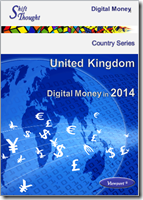Today I am delighted to be speaking to Jonathan Vaux, Executive Director, New Digital Payments and Strategy at Visa Europe. Jonathan tells us what trends impressed him over 2014, which he considers to be a really powerful year for mobile payments. We discuss the UK and European developments and Jonathan shares his views on the outlook for 2015 for digital payments in Europe and world-wide. For background see my previous blog “How payments changed in UK in 2014 and what’s next”
Jonathan, thanks for making time for this discussion. Could you please tell us a bit about yourself and your remit at Visa Europe?
 Really I have two major roles at Visa Europe. Firstly, to look at emerging technologies and gauge what our involvement should be. Is this a technology so impactful we must do something about it but not necessarily be a provider? A good example of this could be authentication or identity, where it’s probably more about us adapting our product rules and frameworks to recognise emerging technologies. Alternatively, is it a service we should provide as part of our core services? A good example of this might be tokenisation, or incorporating geo-fencing into our services as a way of improving our authorisation services and improving the customer experience to approve genuine transactions and help capture fraudulent ones.
Really I have two major roles at Visa Europe. Firstly, to look at emerging technologies and gauge what our involvement should be. Is this a technology so impactful we must do something about it but not necessarily be a provider? A good example of this could be authentication or identity, where it’s probably more about us adapting our product rules and frameworks to recognise emerging technologies. Alternatively, is it a service we should provide as part of our core services? A good example of this might be tokenisation, or incorporating geo-fencing into our services as a way of improving our authorisation services and improving the customer experience to approve genuine transactions and help capture fraudulent ones.
Secondly my job is to create roadmaps and conduct prioritisation exercises.
At Visa Europe my job is really to look at changes in the way people want to pay and make sure that Visa is the preferred payment method for whatever app or wallet consumers wish to use for payments.
How has Visa Europe recently reorganised to address opportunities from changes in the way we pay?
We’ve undertaken a major reorganisation recently that resulted in positioning us very well with respect to the changes we expect in payments over 2015 and beyond. We have created a dedicated digital business unit as a group of 150 people looking at the services we must provide and also delivering the services. This is a dedicated team currently separate from our “core” business.
We want to make sure we are as easy to integrate into new banking and payments apps as possible, creating the connectivity and seamless payments experience consumers require.
What are some of the key global trends you observed over 2014?
To my mind 2014 was a tipping point for NFC payments. With the launch of Apple Pay and the number of developments over the year, some technologies that had been struggling to get adoption got legitimised. There has been more emphasis on customers wanting personalised services. Also we’ve seen much more adoption of online banking and mobile banking. More than ever banks have started to engage with digital channels, as an imperative rather than an option.
We saw some important traction in the role of biometrics, with TouchID for instance, and the technologies becoming more open.
Tokenisation is another major development. Another is the evolution of players such as Stripe with an open API approach. In short, 2014 has been a really powerful year for payments innovations.
On the other hand we had so many negative incidents, such as credit cards being stolen, that in a way may also precipitate tokenisation, and make paying by mobile even safer than other methods?
We need to make sure we consider this as we evaluate how to scale any potential new technologies, although the issues did not arise due to mobile as a channel as such just re-emphasised the importance of security.
Also if you look at fraud ratio in Europe, thanks to implementation of Chip and PIN, the rates are relatively low as compared to US for instance. In Europe there is more nervousness about technologies that are seen as less safe.
The other important point is we need to ensure that the way to mitigate fraud does not impact consumer experience. It is all about creating streamlined, secure methods to pay with consumer experiences that are also great.
On the topic of focus on consumer experience, do you see digital as an opportunity for banks to safeguard against becoming commoditised and also regain consumer goodwill?
As a general point most people look to retail banks to manage funds and trust their bank to keep their money safe. If you consider core propositions in this area, the customer looks to their primary retail bank for that. I’m not sure how much the potential peripheral services, such as loyalty, have a material effect in terms of customer relationship - the crux of it is: Is my money safe? Am I protected if something goes wrong?
However, a lot of day-to-day experiences in the banking world may not be consumer friendly enough. Consumers may shift for more convenience. PayPal, for instance, have had a lot of impact as they offered such a strong customer experience.
Over 2014 we saw so much traction in the UK with Transport for London (TfL). Could you please tell us more on this?
A lot of the services fail as they don’t become habitual for the customer. What is fantastic about applications such as TfL is that for people living and travelling around London the use of such services becomes habitual very fast. The use of contactless payments on TfL extends and reinforces the use of that plastic card that I use elsewhere. It’s a new use case and it works as it is something I use regularly.
It is interesting to see the number of transactions and also the number of people constantly using contactless cards has greatly increased over 2014.
Visa Europe predicts that, with the launch of contactless journeys on Transport for London’s (TfL) travel
network and the introduction of mobile contactless services, Brits will make 500 million contactless payments between now and December 2015.
Any update for me in terms of the use of mobile contactless payments? Now that services are available from some of the leading mobile operators, how are these being used so far?
I am not sure how much specific data I can share on that but I would say that today most transactions are still predominantly contactless plastic cards. We’ll probably see more focus from the operators in trying to capitalise on the press attention that things like Apple Pay’s launch in the US have received to grow their share of transactions and I think we’ll hear a lot more about wearables in 2015.
Within Europe, please could you describe some of the unique characteristics you have observed?
The big challenge for Europe is there are still lots of local processing systems despite Pan-European discussions. In 2014 we saw domestic regulators becoming more stringent on some issues, such as data storage required to be in the country, not overseas. This is an interesting trend that’s emerging. Over 2015 we must see how much that may counter-balance the speed rollout for global brands. It may also affect the scale of roll out of digital payments, and how that differs.
I agree it’s not just one market. I’m wondering if you have an update for me on Eastern European (EE) markets. I’m recently back from Poland and it was interesting to see the developments there.
Yes, there are a number of benefits in terms of markets such as Poland which have been very early adopters of contactless payments. There is a really high usage of contactless there. Merchants are actively leveraging technology to drive loyalty behaviour.
Nine Polish banks have confirmed plans to commercially launch Visa Cloud-based Mobile Contactless Payment services from early this year, re-enforcing Poland’s reputation as a hotbed for innovation in digital payment services.
Banking providers ING Bank Śląski, mBank, Bank Millennium, Raiffeisen Polbank, eurobank, Getin Bank, Bank Polskiej Spółdzielczości and Bank SMART will join Bank Zachodni WBK in rolling out services utilising Visa’s Cloud-based Payment specifications, enabling customers with payment apps utilising Host Card Emulation (HCE) functionality to make contactless payments quickly and safely using an NFC-enabled Android smartphone.
Poland tends to act more as a homogenous market, with more collaboration, as compared to some of the more developed markets in Western Europe. Sometimes entrenched legacy systems can actually be a constraint. So we are seeing some of the EE markets leapfrogging other European markets. They are building shared infrastructure backed by enabling rather than differentiating technology.
How do you see Tokenisation evolving – what are the promises and potential challenges?
Tokenisation already exists today and works successfully in a lot of online markets. It is important to look at the different use cases, and the ways it adds value and cost. With margins coming down markedly we need to be sure we don’t add layers of cost where it’s difficult to make sufficient money to justify this.
So if you compare the EU against US, the margins are very different in Europe. My customer asks, what’s the investment case? So there is little money to cover the costs, unless it gives significant upside.
I suppose big markets such as India and China already have their own cards roadmap. When we were in India recently we saw Rupay debit cards being issued for 53 million new accounts opened in just 2 months. What do you see in terms of global outlook?
The important thing is how do you transition quickly? It is a case of not just issuance but creating the necessary acceptance infrastructure. Time to scale of this would be a key differentiating factor.
Thanks Jonathan, this has been most interesting. To conclude, what do you most look forward to in 2015?
I think we’ll start to see material changes, new use cases and increasing adoption of the exciting new technology. As some of the things start to roll out I believe 2015 will be a really critical year as the new services become the norm and pilots go mainstream.
Which are the new technologies you would back?
You will see NFC, HCE, QR codes and more but as Visa we are agnostic. You will see these become more frequently used methods. You’re going to have very different consumer experiences. If Tesco offers a QR code app, that will be possible, just as other use cases such as NFC or HCE must also be possible, and that’s what we at Visa Europe are working hard to ensure the necessary support.
|
|
Jonathan Vaux is Executive Director, New Digital Payments and Strategy at Visa Europe. Jonathan is responsible for the development and execution of the New Digital Payments Propositions Strategy for Visa Europe. Key responsibilities include development of innovation agenda, development of digital roadmap and management of key partnerships and interaction with innovation partners, including startups, incubators and accelerators. |
This is part of Shift Thought’s Focus on UK Series. Shift Thought provides unique, detailed and up-to-date Country Viewports on most developed and emerging markets around the world. Talk to us today at +44 (0)754 0711 848, or write to us at contact@shiftthought.com to learn more about how we can support your digital banking, digital payments and remittances projects.











